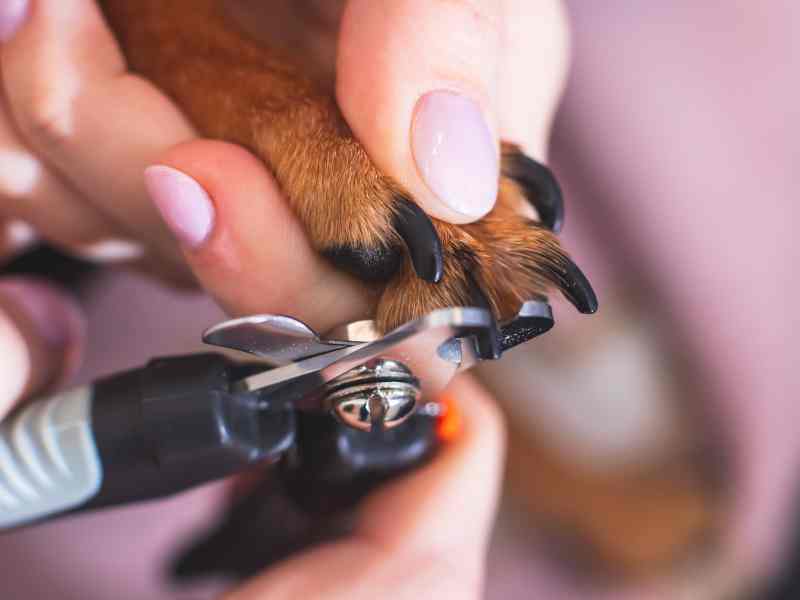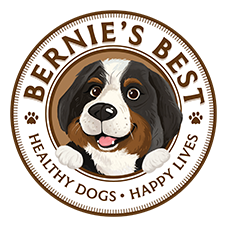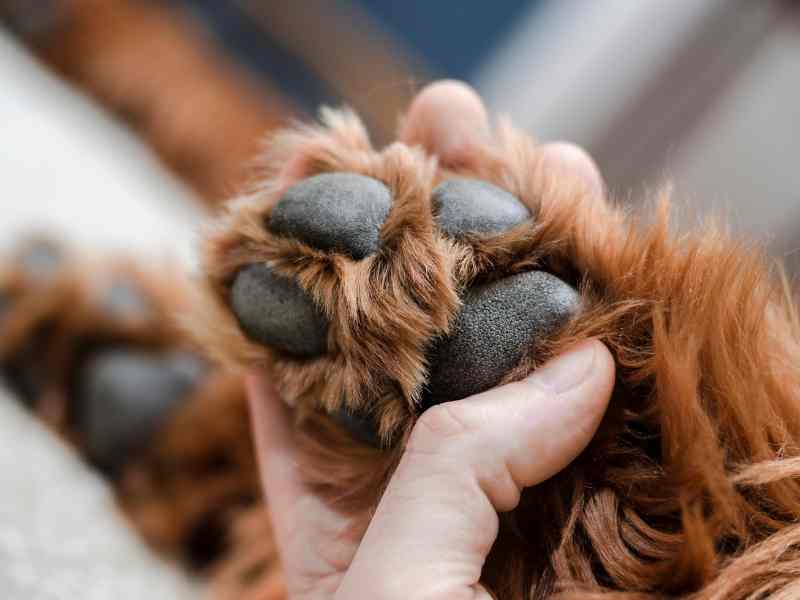Healthy dog paws are essential not only for walking, running, and playing but also for preventing injuries that could lead to mobility issues down the line. Proper dog paw care—cleaning, inspecting, and protecting—is a critical aspect of pet health that often goes overlooked. By prioritizing paw health, you’re not just ensuring your furry friend can continue to enjoy their daily strolls and adventures; you’re also safeguarding them against potential discomfort and diseases.
The Anatomy Of A Dog’s Paws
The anatomy of a dog’s paw is pretty cool—it’s built tough to handle everything from lazy walks to full-on sprints after squirrels. Your dog’s paw is like a mini shock absorber. Each paw has pads (the thick, spongy part that actually touches the ground), claws, and digital pads, along with the metacarpal (front) or metatarsal (rear) pads and the dewclaw in some dogs.
The pads cushion and claws grip. The carpal pad acts as a sort of brake. All of those parts of the paw work together to support not only the weight of the dog but also absorb shock, provide insulation against extreme temperatures, and help them stay balanced.
Problems With A Dog’s Paw Pads
Like us, dogs can run into paw troubles that mess with their mobility. Things like cuts, scrapes, or burns on their pads from rough or hot surfaces can really slow them down. Overgrown or broken nails can make it awkward for them to walk and even hurt their joints over time. Think about it–if your toenails prevented you from standing appropriately for any length of time, that’d take a toll on your foot bones and joints. Since those are key to keeping the rest of our bodies upright and balanced, toenail care can affect so much more than we think. And let’s not forget about infections—nasty stuff like bacteria or fungus can get in there, especially if they step on something sharp that gets stuck.
These issues are more than just uncomfortable; they can actually make it hard for your dog to get around and enjoy their usual activities. When they’re not able to be as mobile as they want, they’re not able to live their best lives. Paw health affects overall mobility, and it’s important you deal with problems quickly, so you can help them be happy and active.
Healthy paws are like the best pair of sneakers your dog could ever wear. They’re essential for all the running, jumping, and playing your dog does every day. When your dog’s paws are in top shape, they can move comfortably, keep their balance, and basically enjoy being their active, happy selves. Good paw health means your dog can walk on different surfaces, from hot sidewalks to icy paths, without a problem. It’s all about giving them the freedom to explore their world without discomfort.
But, when paw health is neglected, things can go downhill pretty fast. Imagine trying to walk around in shoes that are too tight, or with a pebble stuck in them—that’s how your dog feels with issues like overgrown nails, cuts, or infections in their paws. These problems can make walking painful and even lead to more serious issues. For example, if your dog starts walking funny to avoid paw pain, it can mess with their joints and lead to long-term mobility problems. Plus, infections can spread and get worse if they’re not treated right away.
Beyond physical pain, think about how being stuck inside because of sore paws can affect your dog’s mood. Dogs love to explore, sniff around, and just be dogs. It can lead to boredom, frustration, and even sadness when they can’t do that. It’s not just about physical health; it’s also about keeping your dog happy and living life to the fullest.
In short, taking care of your dog’s paws is a big deal. Regular checks, keeping nails trimmed, and dealing with any issues quickly can make all the difference. Healthy paws mean your dog can keep moving smoothly, enjoy every adventure, and live its best life. And that’s what every dog owner wants for their furry friend.
Recognizing Paw Pad Injury And Problems
Spotting dog paw problems early can save your dog a lot of trouble and keep those tails wagging on their daily adventures. Here’s what to watch for in your dog’s paw pads and how to handle issues that may come up:
Signs of Paw or Paw Pad Problems
- Limping: If your dog’s not walking right or favoring one leg, it’s a red flag. They might have stepped on something sharp, have a sore paw, or worse. You want to get to the root of the issue as quickly as you can to save them pain and prevent paw injuries from worsening.
- Licking or Biting Paws: Dogs naturally clean their paws, but if they’re going at them like there’s no tomorrow, something’s up. It could be anything from a splinter to an allergy. When you see dogs ‘chewing’ at their paw pads, you also want to be on the lookout for possible ‘hot spots’ developing, as that can make the problem even worse. If it’s something like an allergy, you’ll of course want to do what you can to help them not have the reaction that causes them to itch and bite so much.
- Swelling or Redness: Are their paws looking puffier than usual? Redness around the pads? These are signs of infection or inflammation; again, you’ll want to get to the bottom of the issue so it doesn’t get worse.
- Changes in Pad Texture: If the pads feel too soft or too hard, that could be a sign of a problem. Healthy pads are smooth and supple; toenail length has a lot to do with the texture of their pads, so you’ll want to be sure they’re always kept neatly groomed.
It’s not uncommon for dogs to have the every-now-and-then issue with their paws, as they do rely on them pretty heavily for movement and general life. And, they’re pretty good about dealing with the random irritant or issue that is likely to resolve with a bit of care. You’re the first line of defense (after them, of course) when it comes to your dog’s paw health. Keeping an eye out for these signs and knowing when to seek help are keys to keeping your furry friend happy, healthy, and ready for their next fun thing. Here are some tips on how you can help support minor dog paw issues:
- First Aid: For small cuts or scrapes, clean the area gently with mild soap and water, and apply an antiseptic. Keep your dog from licking the wound with a pet-safe bandage or cone.
- Nail Troubles: If a nail is cracked or broken, you might be able to trim the sharp part carefully. But the vet’s probably the next best stop if it’s bleeding or seems painful.
- Paw Pad Care: Minor burns from hot pavement or cold injuries from ice can often be treated at home with cool water rinses and protective balms. But, again, if it looks really bad or doesn’t get better, see the vet.
If your dog continues to show signs of issues with their paws or paw pads after attempting minor treatments, you really need to find out why and get help. Compromised paws or dog paw pads affect their overall mobility, so if any of the following happen, you want to contact your vet:
- Persistent Issues: If the limping, licking, or swelling doesn’t improve in a day or two, or if it gets worse, it’s time to call the vet.
- Visible Injuries: Deep cuts, punctures, or objects stuck in the paw typically need professional attention. Trying to help at home may make things worse.
- Signs of Infection: Does your dog’s paw smell horrible? Is there any blood or discharge? Does it feel exceptionally warm? These are SOS signals for a vet visit.
 How Can I Keep My Dog’s Paws Healthy?
How Can I Keep My Dog’s Paws Healthy?
Keeping your dog’s paws in tip-top shape is a daily commitment that pays off in ensuring their mobility and overall well-being. Here’s how you can incorporate paw care into your daily routine to keep your furry friend happy and on the move.
Keeping Paws Clean
Routine paw cleaning is more than just a nicety; it’s a necessity. After each walk or outdoor adventure, take a moment to wash your dog’s paws with warm water and mild soap. And we get it…that may not always be easy. Many paw wipes and sprays on the market can help make it a little easier to get into the habit.
This simple step removes dirt, debris, and harmful substances like road salt or lawn chemicals that can irritate or damage their pads. Regular checks are also important. Make it a habit to inspect your dog’s paws for thorns, pebbles, or other foreign objects that could become embedded in their pads or between their toes. Early detection and removal can prevent discomfort and potential infections.
The Importance of Regular Nail Trims
Nail care is not just a cosmetic concern; it’s a biggie for your dog’s mobility. Overgrown nails can cause many problems, from altering how your dog walks to potentially causing joint pain and arthritis. Ideally, a dog’s nail should not touch the ground when they stand. Regular trims keep the nails at a healthy length, allowing your dog to walk and run comfortably and naturally. If you hear your dog’s nails clicking on the floor, it’s a sign they’re too long and due for a trim.
Protecting Paw Pads
Your dog’s paw pads are tough, but they’re not invincible. Exposure to harsh surfaces like hot asphalt in the summer or icy sidewalks in the winter can lead to burns or frostbite. Investing in protective gear like dog booties can provide a barrier against extreme temperatures and rough terrains. If your dog isn’t into wearing something to protect their paws, paw balms are a great alternative for providing a protective layer and soothing any existing irritation. Additionally, during extreme weather conditions, try to limit your dog’s exposure to harmful surfaces or opt for walks during cooler parts of the day to avoid peak temperatures.
Enhancing Dog Mobility Through Paw Health
Enhancing mobility in our furry friends starts from the ground up, quite literally, with their paws. The health of a dog’s paws is the basis of their overall ability to move and enjoy life to the fullest. We can significantly improve and maintain our dogs’ mobility through exercise, proper nutrition, and attentive care.
Exercise: A Foundation for Paw Health and Mobility
A dog’s daily routine should include regular, moderate exercise. This isn’t just about keeping them fit; it’s about ensuring their muscles and joints remain strong and supple, directly impacting their paws’ health. Activities that involve different terrains can be particularly helpful. They strengthen the paw pads and improve a dog’s balance and coordination. From sandy beaches to leaf-covered trails, varying the walking surfaces can challenge and strengthen their paw health, laying a solid foundation for their best mobility.
Paw Massages and Preventive Care: Enhancing Mobility Through Attention and Protection
Incorporating regular paw massages into your dog’s care routine can yield significant benefits. It’s an easy and simple act that improves blood circulation to their paws, enhances flexibility, and helps you discover potential issues like cuts or foreign objects. Additionally, when you use paw waxes or balms, especially when facing extreme temperatures or rough terrains, you can make that massage even more beneficial. Many products are designed to create a protective barrier, defend against hot pavements, icy conditions, and chemical irritants, and ensure that our dogs’ paws are protected against the elements.
Regular checks and care are also helpful in preventing minor paw problems from escalating into serious issues that could impede a dog’s mobility. Using pet-friendly products for treating minor cuts and ensuring protective gear for outdoor adventures are practical steps toward maintaining optimal paw health.
Fostering Trust and Bonding Through Gentle Paw Handling
In our journey to ensure optimal paw health for our beloved canine companions, it’s vital not to overlook the importance of building trust and bonding through gentle paw handling. Some dogs may naturally feel uneasy or even resistant to having their feet handled, especially if they’ve experienced discomfort or pain. However, by incorporating positive reinforcement techniques and gentle handling into their foot care routine, we can pave the way for a smoother and more enjoyable experience for both dog and owner. Establishing positive associations with paw handling before any painful issues arise can significantly alleviate potential stress or anxiety, fostering a stronger bond between you and your furry friend. Remember, patience, understanding, and a gentle touch are key elements in nurturing a trusting relationship and ensuring your dog’s paw care routine is a positive and rewarding experience for everyone involved.
Nutrition: The Role of Diet in Dog Paw Well-being And Mobility
A dog’s diet plays a pivotal role in maintaining the health of their paws. Essential nutrients, particularly Omega-3 fatty acids from sources like fish oil, are vital for healthy skin and paw pads. A balanced diet packed with vitamins, minerals, and antioxidants supports the paws and their entire body. Good nutrition helps guard against environmental damage and ensures that the paw pads remain resilient against the daily wear and tear of life’s adventures.
At Bernie’s Best, we adore our dogs – they are family. And just like any family, we want what’s best for them. That’s why we’ve meticulously chosen ingredients that are beneficial and supported by solid scientific evidence for promoting health and mobility in our beloved four-legged friends. We didn’t jump on the popular bandwagon, but went with ingredients that really pack the punch.
Why We Choose The Ingredients In Marvelous Mobility.
Omega Fatty Acids, such as those found in flaxseed, anchovy, and algal oil, are key players in health. These aren’t just good for a shiny coat – they are powerful anti-inflammatory agents. Omega-3s, EPA and DHA, are shown to support joint health by reducing inflammation, which can be a major culprit in mobility issues. We believe in tackling the root cause, not just masking symptoms.
Antioxidants are like your dog’s body’s personal security team. They guard against free radical damage, which can lead to inflammation and mobility issues. By including astaxanthin and blueberries, we’re equipping your dog’s body with the defense it needs to stay energetic and active.
When it comes to reducing inflammation, we opted to stay away from synthetic when nature offers such effective, research-based options. Turmeric, green tea extract, Boswellia, and Yucca root have been recognized through research for their natural anti-inflammatory properties. They’re gentle yet effective – exactly what we want for our dogs and their overall health.
And we can’t talk about mobility unless we talk about collagen – specifically, Undenatured Type-II Collagen. Unlike the commonly marketed glucosamine and chondroitin, Undenatured Type-II collagen supports the immune system’s response to prevent the breakdown of cartilage. This is a proactive, not reactive, approach to joint health, and it’s rooted in science. That’s what we’re guided by–science, not trends. Recent studies have shown that the benefits of ingredients like glucosamine and chondroitin are not as definitive as once believed, with some research indicating little to no advantage over placebos.
We stand by our choice of ingredients that have a stronger backing by scientific research. We prioritize what’s truly beneficial for your dog’s health and are committed to providing a product that delivers on its promises. For us, it isn’t just a business decision; it’s a reflection of our love for dogs and our commitment to their health.
Because that’s what family deserves – Bernie’s Best.


